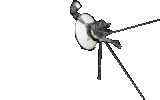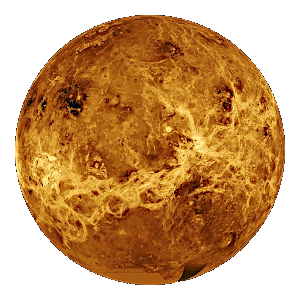
1.
Our Sun2.
MercuryVenus
Our Moon Mars3.
Asteroid Belt4.
Jupiter Saturn Uranus Neptune5.
Pluto6.
Comets
Venus is the second planet from the Sun. It is named after the Roman goddess of love and beauty. It orbits the Sun every 224.7 Earth days With a rotation period of 243 Earth days. It takes longer to rotate about its axis than any planet in the Solar System and does so in the opposite direction to all but Uranus.
Venus is the second-brightest natural object in the night sky after the Moon, can cast shadows and is sometimes visible to the naked eye in broad daylight. It lies within Earth's orbit, and so never appears to venture far from the Sun, either setting just after dusk or rising bit before dawn. Venus and Mercury are the only planets in the Solar System which have no moons.
Venus is a terrestrial planet and is sometimes called Earth's "sister planet" because of their similar size, mass, proximity to the Sun, and bulk composition. It is radically different from Earth in other respects having the densest atmosphere of the four terrestrial planets and consisting of more than 96% carbon dioxide. The atmospheric pressure at its surface is 92 times that of Earth.
Even though Mercury is closer to the Sun, Venus is by far the hottest planet in the Solar System, with a mean surface temperature of 462 °C. It is shrouded by an opaque layer of highly reflective clouds of sulfuric acid, preventing its surface from being seen from space in visible light.
Venus may have had water oceans in the past, but these would have vaporized as the temperature rose due to a runaway greenhouse effect. Its surface is a dry desert interspersed with slab-like rocks and periodically resurfaced by volcanism.
As the planet with the closest approach to Earth, Venus has been a prime target for early interplanetary exploration. It was the first planet beyond Earth visited by a spacecraft and the first to be successfully landed on. Venus's first detailed maps did not emerge until the arrival of the Magellan orbiter in 1991.
In January 2020, astronomers reported evidence that suggests that Venus is still volcanically active.
Reference: Wikipedia - Venus
A spacecraft mission
to explore our Solar System starts with its launch from earth using a rocket launcher. The spacecraft then uses its own engines to reach its objective and carry out its mission. Some missions have multiple objectives.
The duration of a mission varies, depending on the craft used and purpose of the mission.
The table below is an overview or all the successful spacecraft missions, to date, used to study the planet Venus. It only includes spacecraft that left Earth orbit to perform their mission.
Point to ℹ for table information. (Table head remains visible while scrolling)
Select the Spacecraft name or Target for more information.
| Img | Spacecraft | Launcher | Country | Year | Mission | Notes | |
| Launch | End | ||||||
| 1 | Mariner 2 | Atlas LV-3 Agena-B | U.S. | 1962 | 1963 | Tets communications from the spacecraft near Venus and perform radiometric temperature measurements of Venus. | First successful Venus flyby; minimum distance 34,773 km |
| 2 | Venera 4 | Molniya 8K78M | U.S.S.R. | 1967 | 1967 | A probe designed to parachute to the surface, and a carrier/flyby spacecraft for delivery and communications relay. | First successful probe to analyze environment, in-place, of another planet. Continued to transmit to 25 km. |
| 3 | Mariner 5 | Atlas-SLV3 Agena-D | U.S. | 1967 | 1967 | Probe atmosphere by radio occultation, measure hard ultraviolet spectrum, sample solar particles and magnetic field above Venus. | Built as a backup to Mariner 4, but improved for an extra mission. Reached a minimum distance of 5,000 km. |
| 4 | Venera 5, Venera 6 |
Molniya 8K78M | U.S.S.R. | 1969 | 1969 | Approaching atmosphere, a capsule containing scientific instruments was parachuted to the surface. Data was returned while the capsule was suspended from the parachute. | Both were very similar to Venera 4 but of a stronger design. |
| 5 | Venera 7 | Molniya 8K78M | U.S.S.R. | 1970 | 1970 | The lander remained attached to the interplanetary bus during the initial stages of atmospheric entry and was then ejected. Once the parachute opened atmospheric testing began. | First successful landing on another planet; signals returned from surface for 23 minutes. |
| 6 | Venera 8 | Molniya-M/MVL | U.S.S.R. | 1972 | 1972 | Atmospheric probe and lander with instrumentation for temperature, pressure, light sensors, gamma ray spectrometer, gas analyzer. | Second successful landing on Venus. Signals returned from surface for 50 minutes. |
| 7 | Venera 9, Venera 10 |
Proton-K/D | U.S.S.R. | 1975 | 1976 | Both acted as communications relay for landers, explored cloud layers and atmospheric parameters with several instruments. | Venera 9 sent the first images from the surface; operated on surface for 53 minutes. |
| 8 | Pioneer Venus Orbiter | Atlas SLV-3D, Centaur-D1AR | U.S. | 1971 | 1982 | Carried 17 experiments to study various aspects. Was also able to observe Halley's Comet from Venus orbit. | Also known as Pioneer Venus 1 or Pioneer 12. |
| 9 | Pioneer Venus Multiprobe | Atlas SLV-3D, Centaur-D1AR | U.S. | 1978 | 1978 | Carried 1 large and 3 small probes to collect data as they descended into the atmosphere. The probes were not designed to land. | All four probes continued transmitting data until impact. One survived and transmitted data from the surface. |
| 10 | Venera 11, Venera 12 |
Proton-K/D-1 8K82K | Russia | 1978 | 1980 | Minimum distance 34,000 km; deployed lander and then acted as communications relay. | Soft landings; failure of some instruments. |
| 11 | Venera 13, Venera 14 |
Proton-K/D-1 8K82K | Russia | 1981 | 1983 | The lander had cameras to take pictures of the ground and spring-loaded arms to measure the compressibility of the soil. | Venera 13 Survived on surface for 127 minutes; Venera 14 for 57 minutes. |
| 12 | Venera 15, Venera 16 |
Proton-K/D-1 | Russia | 1983 | 1985 | Radar mapping from orbit. | Both spacecraft were identical. |
| 13 | Vega 1, Vega 2 |
Proton 8K82K | Russia | 1984 | 1987 | Both had a landing probe and balloon to study the atmosphere and the surface. | After releasing their landers both spacecraft were redirected by Venus' gravity to intercept and study Halley's Comet. |
| 14 | Magellan | Space Shuttle STS-30 / IUS | U.S. | 1989 | 1994 | Map the surface using synthetic aperture radar and measure the planetary gravitational field. | Also referred to as the Venus Radar Mapper. |
| 15 | Venus Express | Soyuz-FG Fregat |
Europe | 2005 | 2015 | Atmospheric studies; planetary imaging; magnetic observations. | First Venus exploration mission of the European Space Agency (ESA). |
| 16 | Akatsuki | H-IIA 202 | Japan | 2010 | 2021 | Uses five cameras working at several wavelengths to study atmospheric stratification and dynamics, and cloud physics. | Also known as the Venus Climate Orbiter (VCO). Failed to enter orbit in 2010. After orbiting the Sun it was successfully placed it into an alternative Venusian elliptic orbit in 2015. |
| 17 | IKAROS | H-IIA 202 | Japan | 2010 | 2015 | Solar sail technology development and interplanetary space exploration. | IKAROS (Interplanetary Kite-craft Accelerated by Radiation Of the Sun). First spacecraft to use solar sailing as propulsion. |
This gallery contains images of spacecraft and their launch vehicles (rockets) used on the above missions. (Numbers relate to the table above)
Thumbnails: Click on a thumbnail image to enlarge it. | Enlarged image: Click on right side of image for next image or on left side for previous image. Click outside image to close.